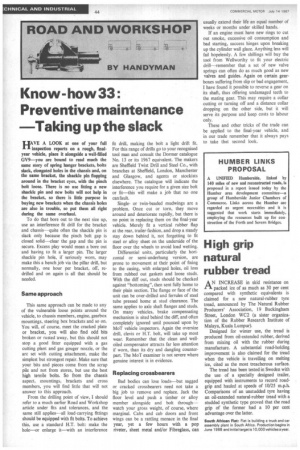Know-how 33 Preventive maintenance Taking up the slack
Page 46

If you've noticed an error in this article please click here to report it so we can fix it.
WAVE A LOOK at one of your full inspection reports on a rough, finalyear vehicle, place it alongside a well-filled GV9—you are bound to read much the same story of spring hanger brackets, bolts slack, elongated holes in the chassis and, on the same bracket, the shackle pin flopping around in the bracket eyes, with the pinch bolt loose. There is no use fitting a new shackle pin and new bolts will not help in the bracket, so there is little purpose in buying new brackets when the chassis holes are also in trouble, so put them all right during the same overhaul.
To do that bore out to the next size up, use an interference fit drill for the bracket and chassis—quite often the shackle pin is slack only because the pinch bolt gap is closed solid—clear the gap and the pin is secure. Excess play would mean a bore out and having to fit a larger pm. The larger shackle pin hole, if seriously worn, may make this a bench job via the pillar drill, but normally, one hour per bracket, off, redrilled and on again is all that should be needed.
Same approach
This same approach can be made to any of the vulnerable loose points around the vehicle, to chassis members, engine, gearbox mountings, steering box brackets and so on. You will, of course, meet the cracked plate or bracket, you will also find odd bits broken or rusted away, but this should not stop a good fitter equipped with a gas cutting plant and gas gouger nozzle, or the arc set with cutting attachment, make the simplest but strongest repair. Make sure that your bits and pieces come from the scrap pile and not from stores, but use the best high tensile bolts. So from the chassis aspect, mountings, brackets and cross members, you will find little that will not answer to this approach.
From the drilling point of view, I should refer to a much earlier Road and Workshop article under fits and tolerances, and the same still applies—all load-carrying fittings should be equipped with fit bolts. To achieve this, use a standard H.T. bolt: make the hole—or enlarge it—with an interference fit drill, making the bolt a light drift fit. For this range of drills go to your recognised tool man and consult the Dormer catalogue No. 13 or its 1967 equivalent. The makers are Sheffield Twist Drill and Steel Co., with branches at Sheffield, London, Manchester and Glasgow, and agents or stockists elsewhere. The catalogue will indicate the interference you require for a given size bolt or fit—this will make a job that no one can fault.
Singleor twin-beaded mudwings are a problem. Once cut or torn, they move around and deteriorate rapidly, but there is no point in replacing them on the final-year vehicle. Merely fit a vertical rubber flap at the rear, trailer-fashion, and drop a steady stay down behind it, not forgetting to fit steel or alloy sheet on the underside of the floor over the wheels to avoid load wetting.
Differential units, particularly the horizontal or semi-underhung version, are prone to movement at their point of fixing to the casing, with enlarged holes, oil loss from rubbed out gaskets and loose studs. With the diff out, studs should be checked against "bottoming", then sent fully home to their plain section. The flange or face of the unit can be over-drilled and ferrules of steel tube pressed home at stud clearance. The same applies to axle shaft flanges and studs. On many vehicles, brake compensating mechanism is sited behind the diff, and often completely ignored until pounced upon by MoT vehicle inspectors. Again the oversize drill, clevis or H.T. bolt, will take up most wear. Remember that the clean and welloiled compensator attracts far less attention if worn, than its dry and dangling counterpart. The MoT examiner is not severe where genuine interest is in evidence.
Replacing crossbearers
Bad bodies can lose loads—but sagged or cracked crossbearers need not take a big job to remove and replace. Jack the floor level and push a timber or alloy member alongside and bolt through watch your gross weight, of course, where marginal. Cabs and cab doors and front wings can be a rattling menace in the final year, yet a few hours with a pop riveter, sheet metal and/or Fibreglass, can usually extend their life an equal number of weeks or months under skilled hands.
If an engine must have new rings to cut out smoke, excessive oil consumption and bad starting, success hinges upon breaking up the cylinder wall glaze. Anything less will fail hopelessly. A few shillings will buy the tool from Wellworthy to fit your electric drill—remember that a set of new valve springs can often do as much good as new valves and guides. Again on certain gearboxes suffering from slip or bad engagement, I have found it possible to' reverse a gear on its shaft, thus offering undamaged teeth to the mating gear. This may require a collar cutting or turning off and a distance collar dropping on the other side, but it will serve its purpose and keep costs to labour only.
These and other tricks of the trade can be applied to the final-year vehicle, and in our trade remember that it always pays to take that second look.


























































































































